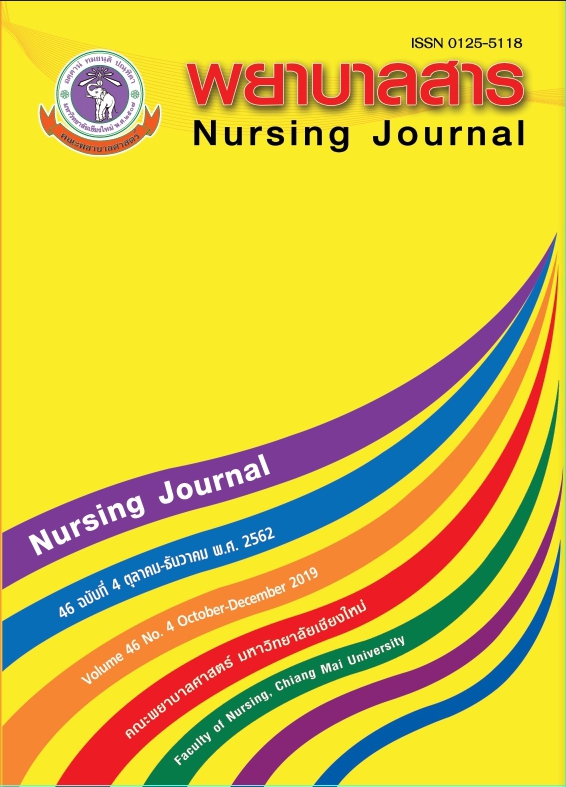Nursing Role in the Promotion of Controlling Blood Pressure Levels in Hypertensive Patients
Keywords:
Hypertension, Controlling blood pressure levels, Nursing roleAbstract
Hypertension is a non-communicable disease and an ongoing public health challenge. It is frequently the cause of cardiovascular disease, cerebral vascular disease, and increases the risk of renal failure. The purpose of this study was to explain the ongoing role of nursing in the controlling of blood pressure levels in hypertensive patients, included analyzing causes of the disease. This study was based on the PRECEDE-PROCEED framework of 3 factor groups, including predisposing factors, enabling factors, and reinforcing factors, and developed health behavior modification patterns by patients’ experience, nurses inserted body of knowledge, and encouragement with literature reviews. The results showed that nurses positively impact patient lifestyle health behavior modification and aid in determining self-efficacy. The encouragement of family participation also positively effects the control of blood pressure levels in patients.
References
June 20, 2019, from https://www.heart.org.
American Heart Association. (2015). Heart Disease and Stroke Statistics 2015 Update.
(Online). Retrieved June 22, 2019, from https://www.heart.org.
American Heart Association. (2016). Heart Disease and Stroke Statistics 2016 Update.
(Online). Retrieved June 20, 2017, from https://www.heart.org.
Benowitz, N.L., &Burbank, A.D. (2016). Cardiovascular toxicity of nicotine: implications
for electronic cigarette use. Trends Cardiovasc Med, 26(6), 515-523.
Brill, J. (2011). Lifestyle intervention strategies for the prevention and treatment of
hypertension. American journal of lifestyle medicine, 5(4), 346- 360.
Bureau of Non Communicable Disease, Department of Disease Control, Ministry of of
Public Health. (B.NCD., DDC. ,MoPH.) (2016-2017). Health Behavioral
Modification Curriculum: Case Manager Nursing. Bankok: The War Veterans
Organization of Thailand. (In Thai)
Centers for Disease Control and Prevention. (2012). Vital Signs: Awareness and
Treatment of Uncontrolled Hypertension Among Adults- United States 2003-
2010. Morbidity and Mortality Weekly Report, 61, 703-709.
Center for Disease Control and Prevention. (2013). Program Planning Case Study:
Prevention of Hypertension.Atlanta, GA: Centers for Disease.
Department of Health Service Support, Ministry of Public Health. (D.H.S.S., MoPH). (2015).
The behavioral modification of stress management for workers. Retrieved June
20, 2019, from https://www.hed.go.th.(In Thai).
Eskridge M. S. (2010). Hypertension and chronic kidney diseases: The role of lifestyle
modification and medication management. Nephrology Nursing Journal, 37 (1), 56-57.
European Society of Hypertension. (2013). Guidelines for the management of arterial
hypertension. European Heart Journal. 34(28), 2159-2219.
Friedman, M. M., Bowden, V. R., & Jones, E. G. (2003). Family nursing: Research,
theory, and Practice. (5th ed.). Upper Saddle River, NJ: Prentice Hall
Green, L.W. & Krueter, M. (2005). Health program planning: An educational and
ecological Approach (4th ed.). New York: McGraw-Hill.
James, P. A., Oparil, S., Carter, B. L., Cushman, W. C., Dennison, H., C. Joel, H.,
J.,…Ortiz, E. (2014). 2014 Evidence-Based Guideline for the management of
high blood pressure in adults. The Journal of the American Medical
Association, 331 (5) 507-520.
Orem, D. E., Renpenning, K. M., & Taylor, S. G. (2003). Self care theory in nursing:
Selected papers of Dorothea Orem. New York: Springer Pub.
Petkeviciene, J., Klumbiene, J., Simonyte, S., Ceponiene, I., Jureniene, K.,
Kriaucioniene, V.,…Lesauskaite. V. (2014). “Physical, behavioral and genetic
predictors of adult hypertension: The findings of the Kaunas cardiovascular risk
cohort study”. Plos one, 9 (10), e109974.
Phetcharat, K., Ponglanga, S., &Kitisri C. (2018). Effect of supportive and educative
nursing system program on self-care behaviors and blood pressure control
among hypertensive patients. Nursing Journal, 45 (1), 37-49. (In Thai).
Policy and Strategy Department, Office of the Permanent Secretary, (2016). Year Report.
Nonthaburi: The War Veterans Organization of Thailand. (In Thai)
Robert, M., Carey M., & Paul, K., Whelton, P.K. (2018). Guideline for the prevention,
detection, evaluation, and management of high blood pressure in adults: A
report of the American College of Cardiology/American Heart Association Task
Force on Clinical Practice Guidelines. Annals of Internal Medicine, 168(5),
351-358.
Suzanne, O.,Amin, Z., and David, A. C.(2003). Pathogenesis of Hypertension. Annals of
Internal Medicine. 139:761-776.
Thai Hypertension Society. (2015). Guidelines in the treatment of hypertension (Update). Retrieved June 20, 2019, from http:// http://www.thaihypertension.org.
Wichai, J., Poldongnok, S. & Sawanyawisuth, K. (2015). Hypertension. Khon Kaen: Klungnana Vitthaya press. (In Thai).
Willem, D. K., Katrien, T., Jan, A., Stefaan, D. H.,& Inge, H. (2015). Effect of sodium restriction on blood pressure of unstable or uncontrolled hypertensive patients in primary care. Nutrition Research and Practice, 9(2), 180-185.
Wutthitham, N. (2018). The Development of family participation pattern to nutrition in
adolescent pregnancy: A case study of Krathum Baen Hospital in Samutsakhon
Province. Christian University of Thailand Journal, 23 (3), 405-515. (In Thai).
Wutthitham, N. (2019). The Development of pattern of behavioral health modification
among hypertension group by family participation : Damnoen Saduak Hospital in
Ratchburi Province Case Study. Nursing Journal, 46 (2), 70-82. (In Thai).
World Health Organization. (2014). Plan of action for the prevention and control of non-
communicable diseases in the Americas 2013-2019. Washington, DC: PAHO.
Downloads
Published
How to Cite
Issue
Section
License
บทความที่ได้รับการตีพิมพ์เป็นลิขสิทธิ์ของวารสารพยาบาลสาร
ข้อความที่ปรากฏในบทความแต่ละเรื่องในวารสารวิชาการเล่มนี้เป็นความคิดเห็นส่วนตัวของผู้เขียนแต่ละท่านไม่เกี่ยวข้องกับมหาวิทยาลัยเชียงใหม่ และคณาจารย์ท่านอื่นๆในมหาวิทยาลัยฯ แต่อย่างใด ความรับผิดชอบองค์ประกอบทั้งหมดของบทความแต่ละเรื่องเป็นของผู้เขียนแต่ละท่าน หากมีความผิดพลาดใด ๆ ผู้เขียนแต่ละท่านจะรับผิดชอบบทความของตนเองแต่ผู้เดียว






